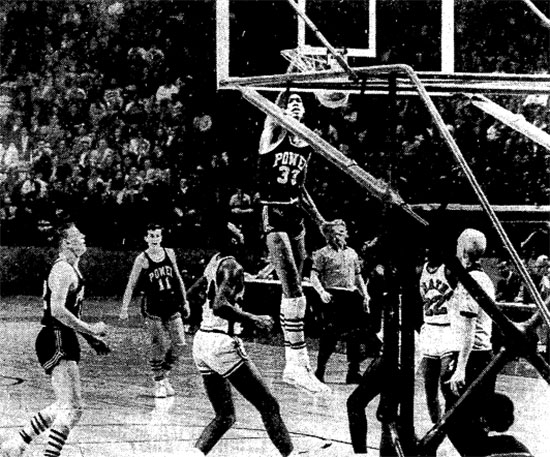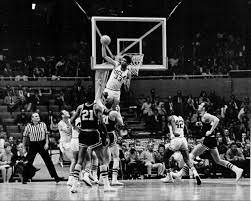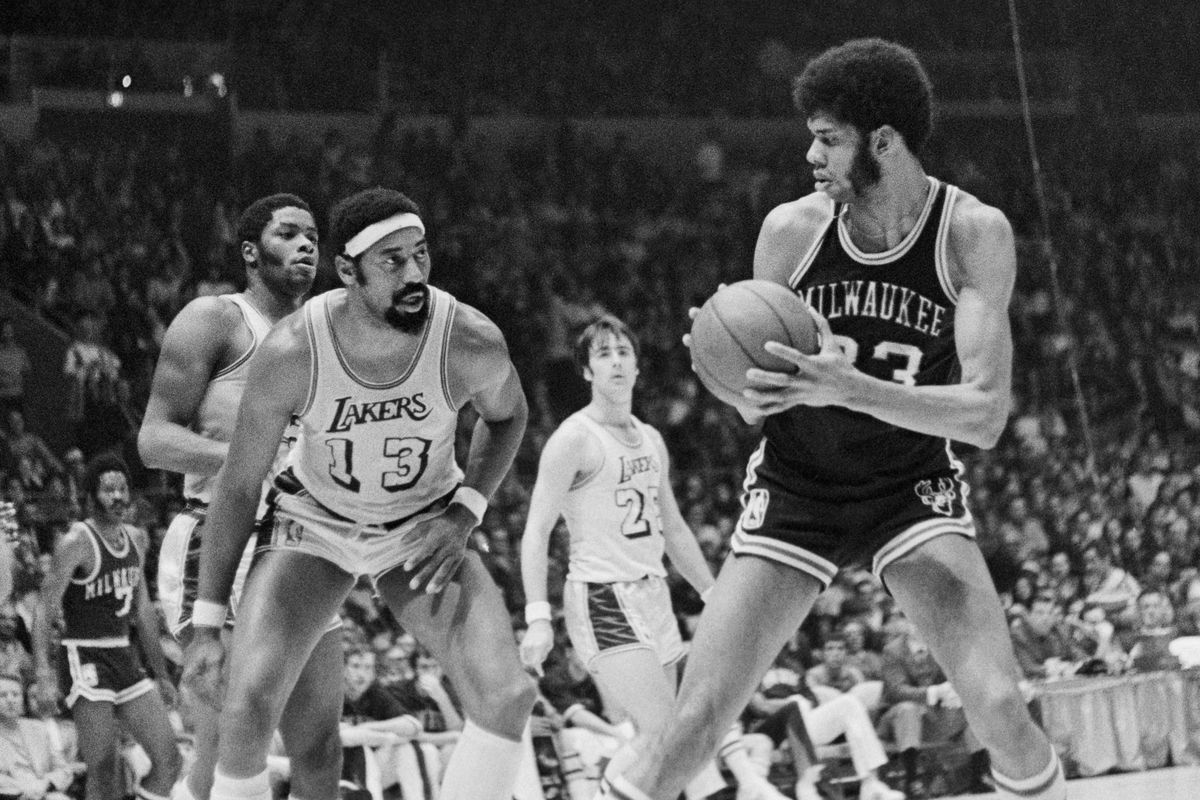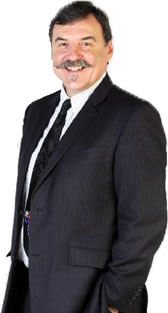Locking horns with Lew, before he was Kareem
Tweet.jpg) LeBRON James may recently have broken Kareem Abdul-Jabbar's NBA all-time scoring record, but there is little doubt the 7ft2in master of the skyhook revolutionised the game, and B.O.T.I. contributor Bob Craven saw him up-close-and-personal during two years of college basketball as he recalls here.
LeBRON James may recently have broken Kareem Abdul-Jabbar's NBA all-time scoring record, but there is little doubt the 7ft2in master of the skyhook revolutionised the game, and B.O.T.I. contributor Bob Craven saw him up-close-and-personal during two years of college basketball as he recalls here.
THERE was a time Kareem was known by his given name, Lew Alcindor, when he was a stand-out player at UCLA and we crossed paths on the court.
He changed his name while with the Milwaukee Bucks in the NBA and is two years younger than me.
He was such a big deal in high school that I had heard and read about him since he was about 15 years old.
His high school in NY City, Power Memorial, became a powerhouse (pun intended) the minute he started to play there. By his senior year, Power had put together a string of 71 consecutive wins, and opposing coaches would often take their teams back into the locker room as soon as Power was about to come onto the court for pregame warmups.
Coaches were quoted as saying they didn't want their kids to see him until they absolutely had to.
 NY City high schools were known to have some very strong teams, and that year those high schools had well over 50 players who were 196cm or taller. The Washington, DC area was also famous for its high school teams, particularly DeMatha, a private Catholic high school that could and did recruit players to play for them, public schools prohibited from doing this.
NY City high schools were known to have some very strong teams, and that year those high schools had well over 50 players who were 196cm or taller. The Washington, DC area was also famous for its high school teams, particularly DeMatha, a private Catholic high school that could and did recruit players to play for them, public schools prohibited from doing this.
DeMatha actually defeated Power with Alcindor in a game arranged between them in the DC area. DeMatha also had two kids in their starting front line who were 204cm and they were successfully able to double team Alcindor.
They had several other players who were D-I recruits, and Alcindor's supporting cast wasn't enough to offset that. A return game in NYC led to a Power Memorial victory over DeMatha.
In any event, the interest in Pac-8 in basketball jumped significantly when John Wooden was successful in recruiting Alcindor to UCLA in Los Angeles. In those days, first year players were not allowed to play on the varsity, so all schools had a freshman team made up of all incoming first year students, plus anyone else who could make the team in preseason tryouts.
If playing at home, the freshman team would play other local college freshman teams, or junior college teams (junior colleges were only two-year schools.)
In those days, Pac-8 teams played league games against each other on Friday and Saturday nights. The Pac-8 then consisted of Washington, Washington State, Oregon, Oregon State, Stanford, California, Southern California, and UCLA.
Teams played league games against each other twice, home and away, each season. My first season on the Oregon varsity, we played UCLA and USC on the road in Los Angeles.
Friday night UCLA was first up, and we all went early to see Alcindor and their freshman team play Citrus Junior College, at the time the #2 ranked JC college in the country.
The UCLA freshmen had six high school All-Americans on their team. We couldn't imagine a high school All-American player who couldn't make the starting lineup of his freshman team in college. Crazy. Anyway, the freshman won the game 152-49 - not a misprint - a 103-point win.
We were seated at the end of the court and high enough up that we were looking down the court through the top of the backboard. A UCLA fast break led to a thunderous dunk by Alcindor. I could see part of his hand and the ball above the top of the backboard before he threw it down with authority.
Citrus JC had a big, and I do mean big, post player, about 204cm and roughly 120 kg. He decided one time to test Alcindor and gave him a couple of fakes before going up with a right-handed hook shot. Alcindor reached right over the top of him and palmed the ball out of his hand before he could release it, then turned and started the break with a long outlet pass.
The top three scorers for UCLA missed only four shots in the whole game. Later, downstairs in the locker room, our coach started off the pregame meeting with the comment, "Well, gentlemen, now you know that you are going to be playing what is only the second-best team at this university."
The following season, Alcindor's first on the UCLA varsity, our first match against them was a home game for us on a Friday. Enthusiasm on the campus and in the city of Eugene was very high.
Our Thursday practices before league games were always a bit light and short, one reason being that the opposing team had the right to practice on the Thursday to get a light run in and to get acquainted with court, the floor, the lighting, shooting background, etcetera.
Students had been crowding around the stadium since the morning waiting to try to get student tickets. In the late afternoon that Thursday, they were joined by crowds of local and regional media. On the Oregon team, we hung around outside waiting to see the UCLA bus arrive with the team.
Alcindor corkscrewed his way down the steps and out the door and was greeted by the media mob. I will never forget when the sports reporter for the Oregon student newspaper, an unpleasant little guy (about173cm) walked up and basically put his nose into Alcindor's stomach, looked up, and then asked, "How's the weather up there?" Alcindor got a disgusted look on his face, spit down into his face, and answered: "Raining".
Before the game, we discussed one thing the scouts had picked up and it directly applied to me. I had noticed also that in rebounding inside him when a UCLA player was shooting, that (at 201cm) I came up to about the point of his shoulder.
We had to hold our inside arm straight up in the air because as his teammate started to shoot the foul shot, he would lean over and put his armpit on top of your shoulder, effectively pinning you to the floor. Easy tip-ins if the shot was missed.
At one point, one of his teammates lost a contact lens. The refs stopped play and gave a few minutes for any who wanted to to help look for it. Down on hands and knees, I looked down the floor and Alcindor was standing at the other basket.
He had one hand leaning against the backboard and had nonchalantly crossed his legs, just resting.
When we defended him, we almost always used me and our centre in a double team, front and back. On one occasion, I was on the weakside and he stepped right around our post player and caught a high pass and baseballed it through the hoop forcefully.
The ball went right past my nose and and bounced well up into the crowd. If I'd been slightly ahead of where I was, it would have hit me in the side of the head, and as fast as it was going, could have caused injury.
In one game in LA, I was also behind him on the weakside when the strongside forward threw a two-handed overhead lob to him. He jumped up, grabbed it with two hands and dropped it through the basket from well above the rim.
I remember the colored waistband of his shorts floating up past my eyes and then floating back down past them. I looked up and it was like looking up at a tall, thin tree. If I had a running start and jumped for all I was worth, I would maybe have reached his elbow,and back then, I could touch the tip of my elbow to the rim.
And his team was not just him, he had a lot of help. In our first game in then-new Pauley Pavilion, the score was 11-0 in their favor before we could get the ball across the centre line. We had a small, quick guard, but he was no match for the quickness of Mike Warren and the rest of their fullcourt press.
The NCAA did not put a shot clock in play until 1985, and even then, it was a 45-second shot clock.
On one occasion on our court, we decided to run what we called a "control" offense - no shots unless you were wide open. It was NOT a stall. We had bigs who could shoot outside, me included, so the idea was stand out past the top of the key and wait for Alcindor to come out on us.
If/when he did, we would give the ball to our all-conference guard and have him go one-on-one to the basket. If stopped, out front it would go again. They didn't like it but it worked, sort of. Near the end we had to open it up and they ended up winning 38-29, and Alcindor was held to single digit points.
Over the years, I've had many people ask "what was it like playing against someone like that", and more to the point, how tall is he really?
During my college days, Dick Enberg was the main announcer for basketball at UCLA. He was a great announcer, and not too long after his time as the UCLA house announcer, he was picked up by national media, announcing for major national networks for decades.
I was on a business trip to LA in the early-1970s one time when I tuned in to a local sports news broadcast and Dick Enberg was the main guest being interviewed. On that show, he was asked the "how tall is Kareem anyway" question.
He told an interesting story about how one time he had been asked by a local charity to be the official judge of a contest they were going to run, where a big prize would be given to the first person who could correctly guess Kareem's height.
At the end of the contest period, he and Kareem mounted a stage where they had a large scale set up to measure height. Kareem stepped in and Enberg measured him officially at 7 feet 4 5/8 inches, that is, about 224cm.
Having stood next to him on the court, I had always suspected that he was taller than the 218cm he was always listed at in college and the NBA..jpg)
TALL ORDER: Bob Craven had his work cut out whenever he played against Kareem.


